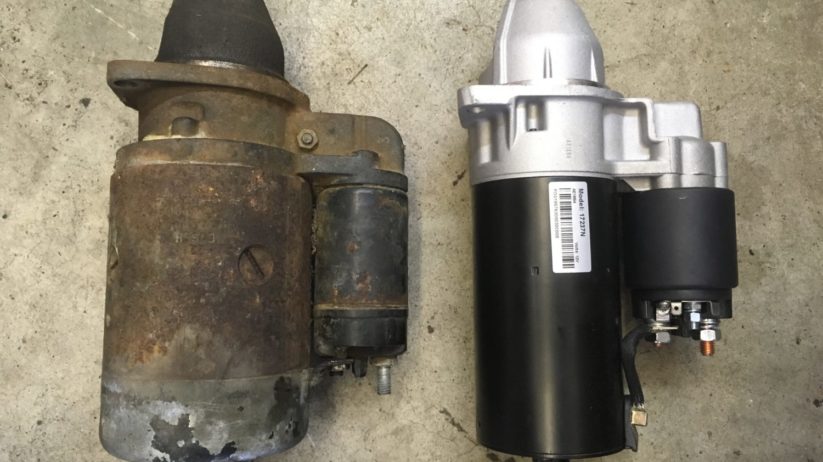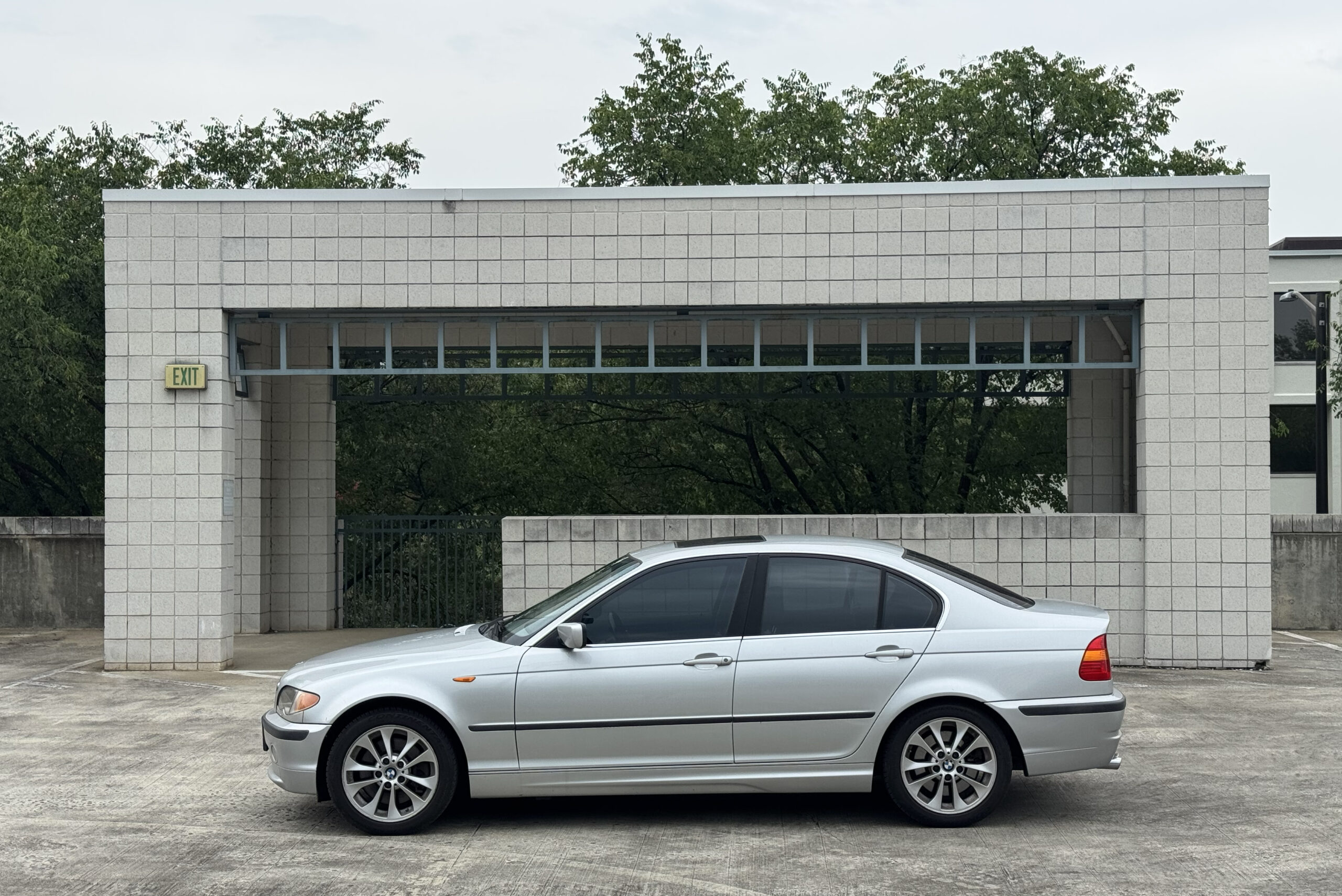It seems like back in the day, I replaced a lot of starters in 2002s and other vintage BMWs. Either they’d gradually get worse, cranking slower and becoming hot to the touch, or they’d suddenly die. Then, for nearly 30 years, nary a single starter was removed in the Siegel garage; instead, alternators and regulators seemed to be the electrical items that went bad as often as the weather.
But in the past few weeks, starters have roared—well, groaned—back to the forefront.
The first was on Bertha. When I initially tried to get her running, there was an awful gnashing sound most times I turned the key. The starter would only engage properly on every third or fourth attempt. I assumed that the teeth on either the starter or the flywheel were bad, and while I had Bertha’s head off, it was a trivial job to reach in and pull out the starter.
To my surprise, both sets of teeth looked fine.
I tested the starter, which you do by laying it on the floor and connecting jumper cables between it and a battery, with the red positive cable attached to the big threaded post and the black negative cable to the case of the starter. Then you stand on it—literally—while you touch another wire from the positive battery terminal to the small spade connector on the solenoid. Standing on the starter is very important, because as soon as it spins, it’ll jump like a hooked bluefish.
When you touch the wire to the small spade on the solenoid, two things should happen (well, three, including the jumping): The pinion gear should thrust forward, and should be spun by the starter. Sometimes, on a bad starter, one happens but not the other. Sometimes neither happens and the starter merely gets hot.
When I tested Bertha’s starter, it again appeared to be fine, but from the gnashing sound I heard when it was installed, clearly something was wrong, so I replaced it with a used but tested one of unknown provenance I had lying around the garage. It worked fine. Problem solved.
The other bad starter was on Kugel, the Chamonix ’72 tii. A few weeks ago, I wrote about solving Kugel’s long-standing problem of being nearly impossible to start while cold. I’d made the car start much easier by replacing a bad distributor cap, but declaring it “solved” was premature; it turned out that the starter itself was going bad, spinning the engine slower and slower, and I, like the frog in the water whose temperature is being turned up, didn’t notice. Well, I did notice, but I didn’t think that it was a root cause of Kugel’s motor not firing over easily. It took a random occurrence of my starting the car at Oktoberfest after the concourse at Heinz Stadium while Ben Thongsai was standing next to it to jolt me into action. Ben heard the car’s slow cranking and immediately gave me the Ben Face. He pointed a finger at me, Invasion-Of-The-Body-Snatchers-style, and said “YOU NEED A STARTER!” (Do not disobey the Ben Face.)
When I got back from O’Fest, I read on bmw2002faq.com about the options for a 2002 replacement starter. The trick thing to do is install a gear-reduction starter for an E30 M3 (Bosch part number SR440X). They’re smaller, lighter, and spin the engine faster than the original unit. Folks rave about them. They’re a little pricey, though, with most vendors charging about $180 for a Bosch rebuilt unit, which includes a $50 core charge. If you’re putting one in an 02, you don’t have an E30 M3 starter core to send back, so you pay the full $180.
The other thing you read is that the starter for a big six M30 engine (e.g. E3, E12, E28, etc) will bolt right up to a 2002’s M10 block, and since it’s designed to spin a six, it provides more torque than the original starter. The Bosch part number for the remanufactured M30 starter is SR441X; it’s a bit confusing, though, because when you search using that part number, you find both the rebuilt full-size versions as well as brand-new, modern, smaller gear-reduction starters like the SR440X. I found one of the latter on eBay from EMSGlobalDirect for $62. Their reputation appeared to be good, so I clicked and bought, figuring that even if the starter died in a few years, I could go through three of them for the price of a rebuilt SR440X M3 starter. When it arrived, I prepared to install it.
First, a major safety point: Whenever you work on a starter or an alternator, you should begin by disconnecting the negative battery terminal. Both the starter and the alternator are wired directly to the battery, so if you’re disconnecting them with a wrench and touch the wrench to the body of the car, you’re going to create a dead short to ground that can badly burn your hand, fry the car’s wiring, and cook the starter or alternator.
On a tii, the next thing you need to do is pull the air-cleaner housing, since it’s directly in the way of the starter. With the battery disconnected, you undo the 13-mm screw holding the positive battery cable to the starter solenoid’s big threaded post, and unplug the small spade connector that runs to the ignition switch.
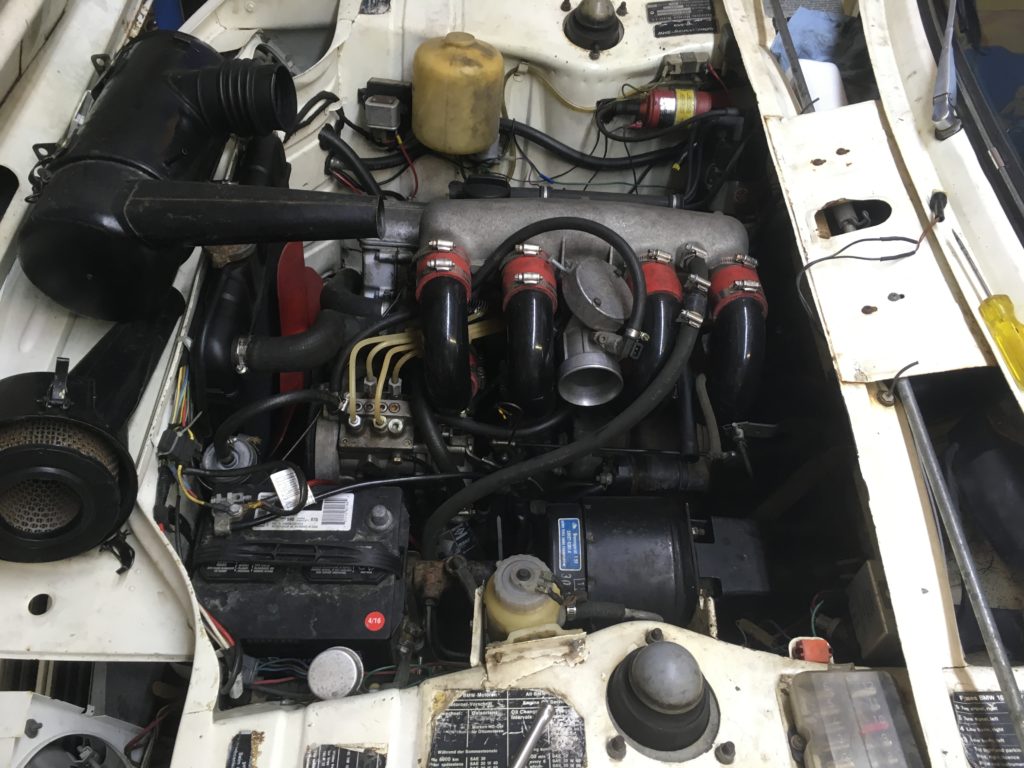
Starter removal begins by disconnecting the battery and, on a tii, removing the air-cleaner housing.
On a modern car, changing a starter is a fairly major operation, since the intake manifold and a fair number of electrical and coolant components are in the way, but it’s not difficult on a 2002. On Bertha, it was cake, because the head was off, giving me completely unimpeded access, but removing Kugel’s starter wasn’t really much more difficult. On a tii, if you remove the two rearward intake plenums and unsnap the long horizontal accelerator-linkage rod, there’s plenty of room to access the starter.
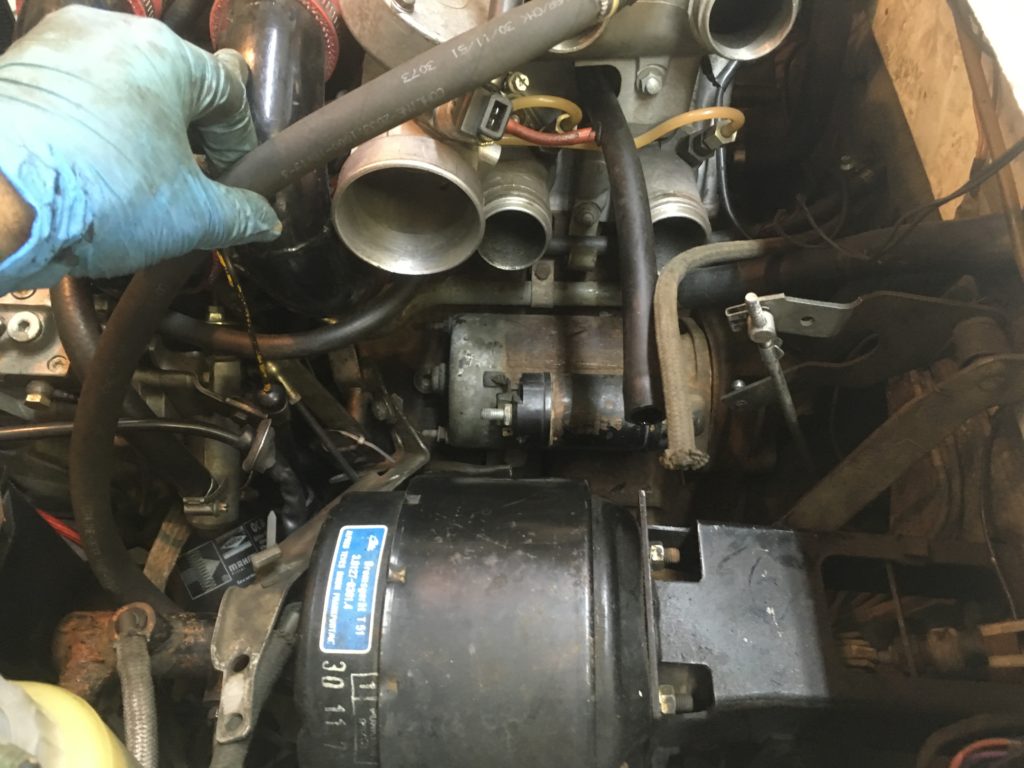
Removing the #3 and #4 intake plenums on a tii makes the starter quite accessible.
With the electrical connections undone, you just need to remove a few bolts securing the starter. On a 2002 and other vintage BMWs, the starter is held in place by two 17-mm bolts and nuts that also secure the the transmission bell housing to the engine block. People make a big deal about clearance being a problem, and sometimes advise that the 17-mm hex-head bolts should be replaced with Allen-head bolts. I’ve found that the older the car is, the less of a problem it is; I’ve never had a problem on a 2002 getting a ratchet wrench and a socket on the heads of the bolts that go through the back of the transmission bell housing, and a box-end or open-end wrench on the nut on the block side.
On a 2002, there’s a mounting bracket bolted to the block that receives two small threaded posts on the back of the starter and secures them using two 10-mm nuts. This bracket is also the attachment point for the battery ground strap. In addition, on a tii, the bracket goes upward and bolts to the side of the throttle body to provide some extra rigidity for the intake manifold, so those two bolts must be removed in order to pull the bracket away.
The SR440X M3 starter has the threaded posts, and thus bolts right onto the rear mounting bracket, but not all of the SR441X starters have these threaded posts. I read that this poses no problem for the SR441X starter, that the back of it clears the bracket without issue, and that if you’re using a gear-reduction model that’s smaller and lighter than the original, it’s supported perfectly fine by just the two through-bolts on the bell housing. Regardless, you still need to undo the mounting bracket to get the original starter off, and this can be challenging. The 17-mm nut holding the bracket to the engine block is very close to the right angle of the bracket. My standard impact sockets won’t fit on it; I need to use a thin-walled socket instead.
If the bracket has been on there for the life of the car, it can be incredibly tight. Watch that when you lean on the ratchet wrench, the tendons on the back of your hand don’t go skittering off into greasy jagged metal when it breaks loose.

This photo shows both how the threaded posts on the back of the original starter are secured to the bracket with two 10-mm nuts, as well as how the 17-mm nut holding the bracket to the block has a clearance issue.
On bmw2002faq, there are a number of threads that say that the electrical terminals on these gear-reduction SR441x starters are somehow reversed from those on a normal starter. On the starter I bought, I didn’t find that to be the case. The positive battery cable went on the big threaded post with the 13-mm nut just like on the original starter. The female spade connector from the ignition switch went on the male spade post on the bottom edge of the solenoid just like on the original starter, although it was on the opposite side of the securing nut, a very minor point. There was a second spade connector on the top edge of the solenoid for cars whose ignitions are wired to bypass the ballast resistor during cranking. My tii doesn’t use this, as a ’72 2002 is wired to use the starting relay instead.
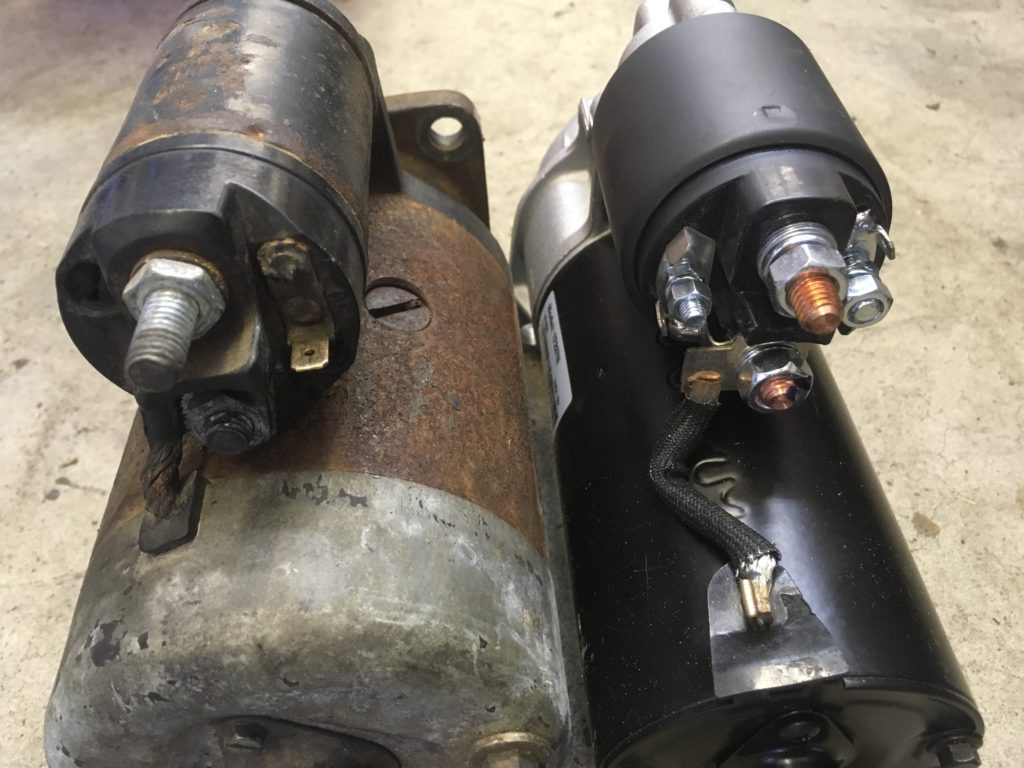
Here’s the comparison of electrical connections between the old and new starters.
After my concern about the bracket-and-threaded-post issue, I was relieved to find that what I’d read on bmw2002faq was correct: The SR441x starter bolted right in place, with no clearance issues at all with the existing tii bracket.
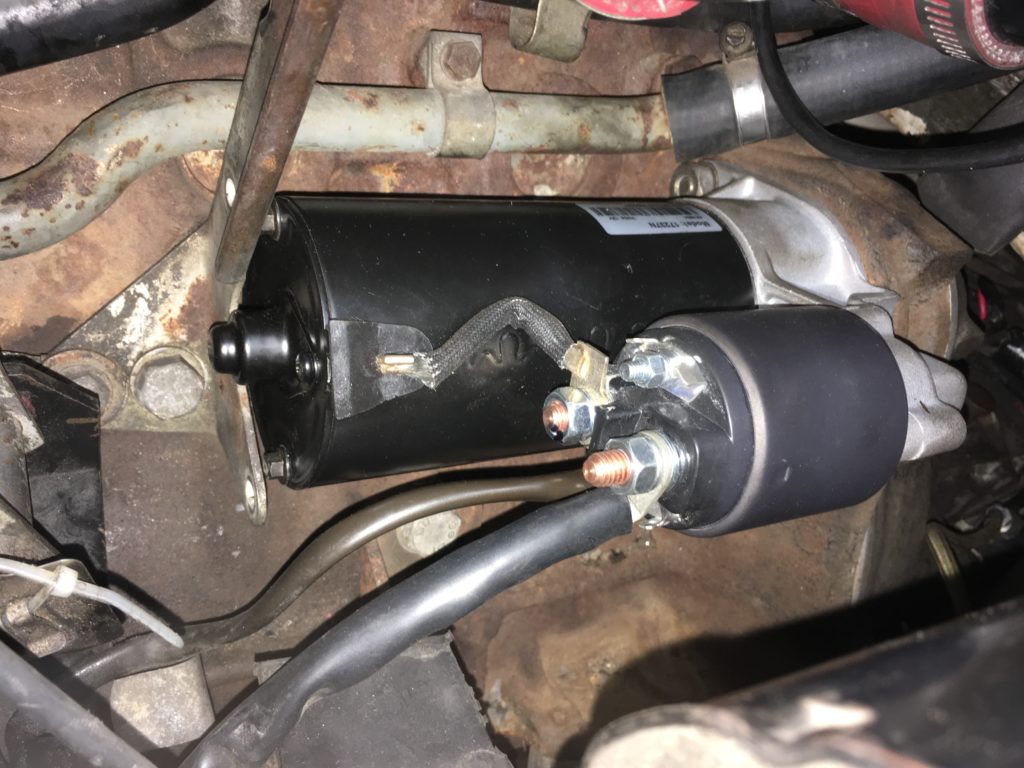
The newly-installed SR441x starter cleared the tii’s bracket with zero issues.
But most important, when I turned the key, the starter cranked the engine over with a ferocity I’d never seen in my six years of ownership of the car—and that, in turn, enabled much easier starting.
Kugel still isn’t like Louie, who fires up almost immediately in both warm and cold conditions with a simple twist of the key. But with the new starter in Kugel, if I depress the accelerator to open up the throttle plate, hit the pushbutton I have installed on the cold-start valve to squirt in a short blast of fuel, relax the throttle so it’s open just a skoshe, and then crank the engine over, it fires up in short order. And that’s a beautiful thing.
And best of all, next time I start the car within hearing distance of Ben Thongsai, I won’t get the Ben Face.—Rob Siegel
(PS: Alert readers may say, “Hey! That was a tale of three starters, not two!” To which I say, “Don’t be a teacher’s pet. It just doesn’t work well in a garage-based ethos.”)
Rob’s new book, Just Needs a Recharge: The Hack MechanicTM Guide to Vintage Air Conditioning, is available here on Amazon. His previous book Ran When Parked is available here. Or you can order personally inscribed copies of all of his books through Rob’s website: www.robsiegel.com.

